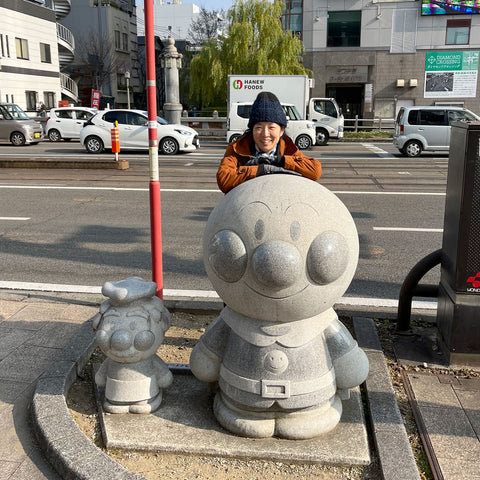
Thermometer at the fermentation room at Kita Shuzo during our 2019 visit
Sake Gumi is our monthly sake subscription service with 200 members throughout the country. Join today!
Sake is unique among fermented beverages in that they can ferment at very low temperatures. While beer and wine typically ferment anywhere between 55°F and 85°F, sake ferments between 32°F and 55°F. Sake is generally able to ferment at lower temperatures because of the fact that saccharification and fermentation happen at the same time – resulting in a lively mash with a constant, healthy supply of sugars.
Finding the right temperature for fermentation is a science. Osamu Nakashima of Nakashima Brewery (maker of Level 1 bottle, Kozaemon Junmai Ginjo) states, "Generally speaking, if the temperature is too high, the desired aroma cannot be obtained, the aftertaste is rough and inharmonious, and the aging does nothing to add flavor. Conversely, if it is too low, the yield will be poor, no aroma or taste will come out, and fermentation will stop."
How is it possible to ferment at freezing temperatures without killing the fermenting mash? The secret lies with the discovery of yeast No. 9 in the 1950s in Kumamoto Prefecture. Often referred to as the "ginjo yeast," No. 9 is able to survive at very low temperatures. Further, in the mid-1980s, brewers discovered that brewing sake with highly polished rice and No. 9 at low temperatures produced fragrances reminiscent of spring blossoms and fruits like apple and banana. Brewers caught on that fermenting low and slow allows more subtle floral and fruity aromas to develop. Ginjo fan's mouths may be watering just about now.
The 1980's was a ripe time for the emergence of low-temperature fermented sake. With markets booming and flavors from all over the world being introduced to Japan, people wanted decadent aromas and sophisticated tastes. Ginjo and daiginjo sakes answered the call with their rich fruity bouquets, and complex flavors.
And so this month, as we discuss low-temperature fermentation (an activity I feel like I'm doing every morning on my frigid walks), I introduce four junmai ginjos to you! Indulge in the low and slow and take in every floral or fruity aroma, accompanied by flavors you can ruminate on, which all end light and clean – like a winter hare running off into the snow.
Kanpai,
Yoko, Co-Founder + Sake Director
+++
 Kozaemon Junmai Ginjo Miyama 55
Kozaemon Junmai Ginjo Miyama 55
Nakashima Brewery (Gifu, Japan)
Seimaibuai: Miyama Nishiki 55%, SMV: +4, Acidity: 1.6
The eye-catching label sports the kamon (family crest) of the Nakashima Brewery. The sake itself is fresh, light, and crisp as the green bottle suggests. With notes of Granny Smith apples, accented by a lemony aftertaste, I enjoyed this sake chilled or at room temperature in wine glasses. Try this sake with steamed mussels, or a baby kale salad. Osamu Nakashima of the brewery tells us that the maximum temperature that this sake ferments at is 54.5°F. When asked about the advances of low fermentation brewing Nakashima replied, “the entire industry is moving to create an environment where low temperature can be managed. For example, the advancements in refrigerated container transportation is remarkable.”
 Exterior courtyard of Nakashima Brewery
Exterior courtyard of Nakashima Brewery
 Akagisan Junmai Ginjo
Akagisan Junmai Ginjo
Kondo Brewery (Gunma, Japan)
Seimaibuai: Gohyakumangoku 50%, SMV: +3, Acidity: 1.3
Made with Gohyakumangoku rice, this sake is made in Gunma with the pristine mineral waters that run off of Mount Akagi. Enjoy this crystal clear sake chilled to enjoy aromas of Fuji apple, banana, and marshmallow with a crisp finish. To enhance the more umami-forward flavors of baby spinach try slightly warmed to 120°F. Enjoy with hamachi sashimi and sliced daikon with a drizzle of your best olive oil.
 Shuhari Omachi Junmai Ginjo
Shuhari Omachi Junmai Ginjo
Matsumoto Shuzo (Kyoto, Japan)
Seimaibuai: Omachi 55%, SMV: +5, Acidity: 1.2
The most active part of fermentation will peak at 43°F, for this sake and most ginjos. Pasteurized just once after bottling gently with less travel time results in a spritzy texture. Enjoy this lively brew in a wine glass to enjoy aromas of mango and cantaloupe while noticing the tiny bubbles come up to the surface. The use of heirloom Omachi rice grown in Okayama Prefecture results in complex flavors ranging from persimmon to fresh green herbs. It all ends clean with crisp acidity! I loved this sake chilled with Fromage Pavé from Trader Joe's and mushrooms sauteed in butter and finished with a splash of shoyu.
 Akabu Junmai Ginjo
Akabu Junmai Ginjo
Akabu Shuzo (Iwate, Japan)
Seimaibuai: Ginginga 50%, SMV: N/A, Acidity: N/A
Another example of a low temperature fermented sake with a refreshing ending, this Junmai Ginjo combines a lively apple aroma with a luxurious note of noyau ice cream. This sake is made with Iwate’s pride and joy Ginginga rice, adding a dimension of savory umami. I’ve always loved Akabu’s ability to brew sakes that have a satisfying acidity that pairs well with ceviche, and salmon with lemon. Enjoy this sake chilled in a thin-rimmed glass and hope for the best in 2023!




Comments (0)
There are no comments for this article. Be the first one to leave a message!